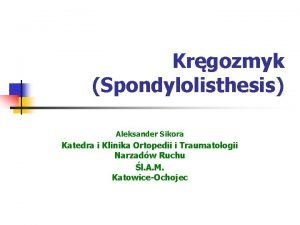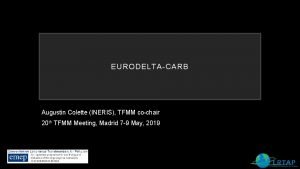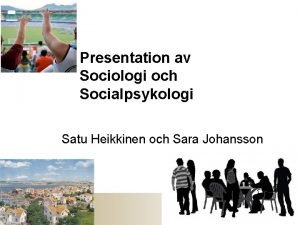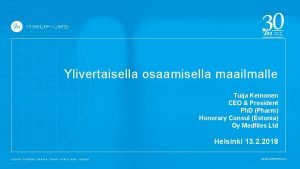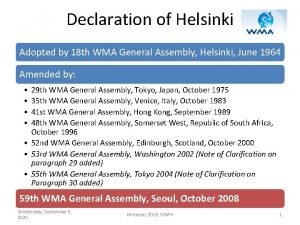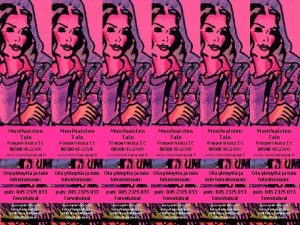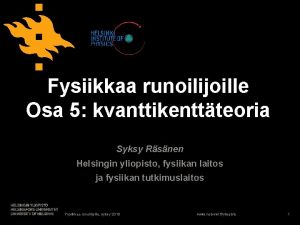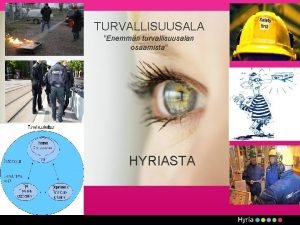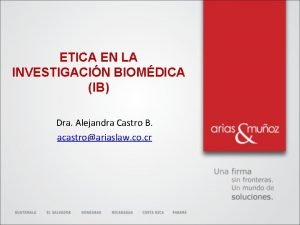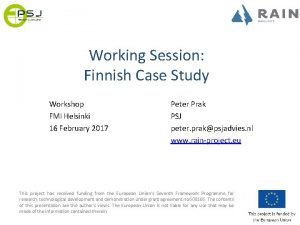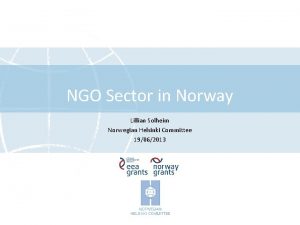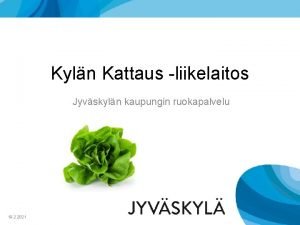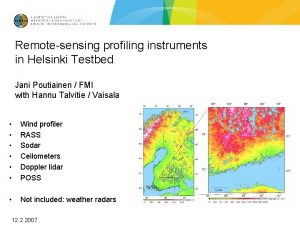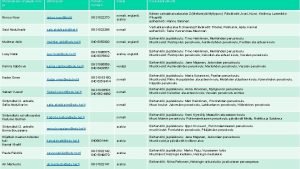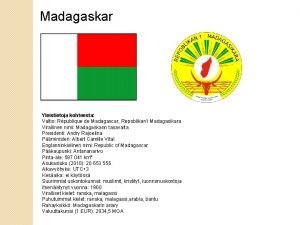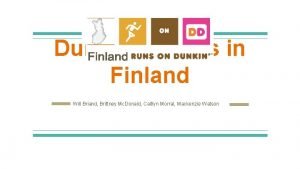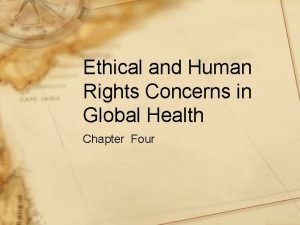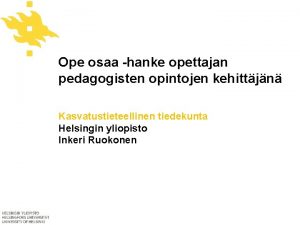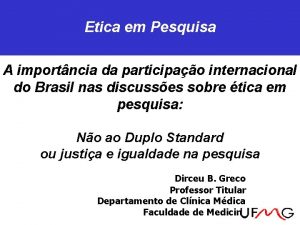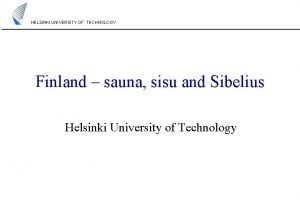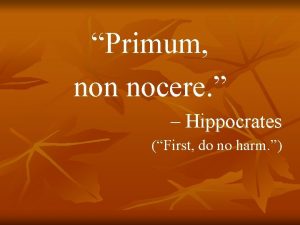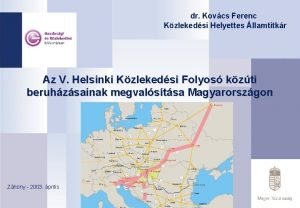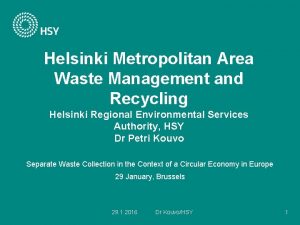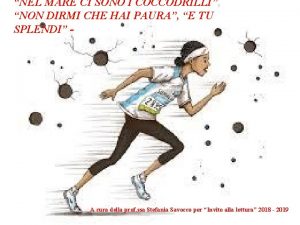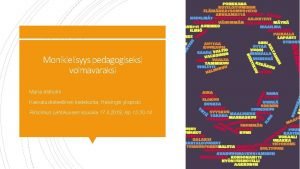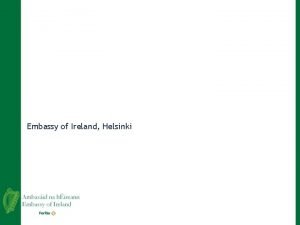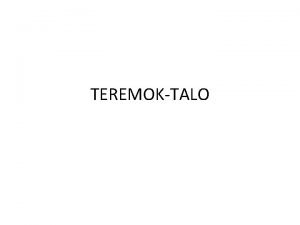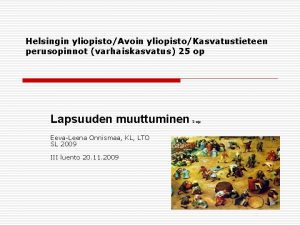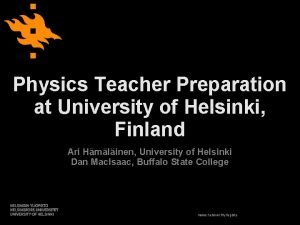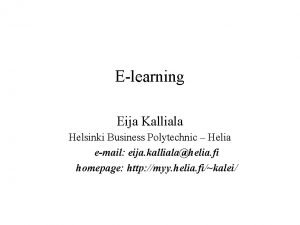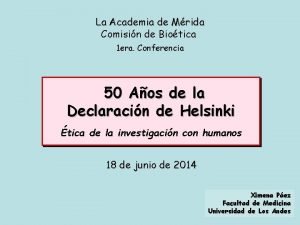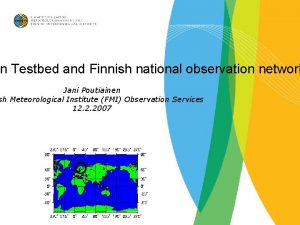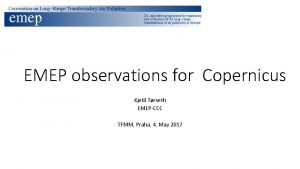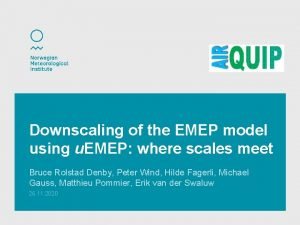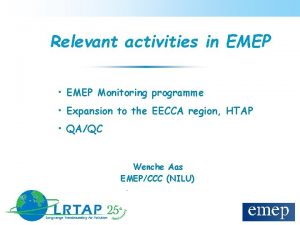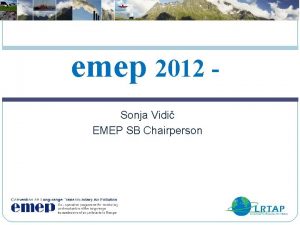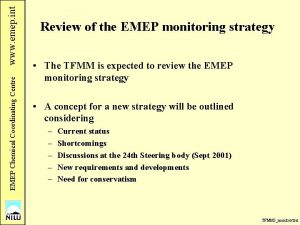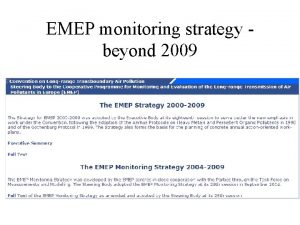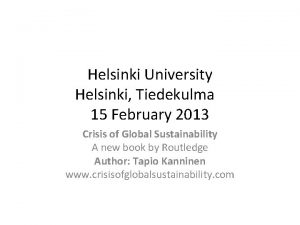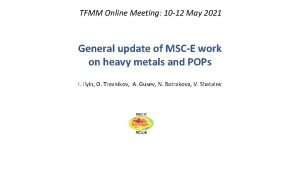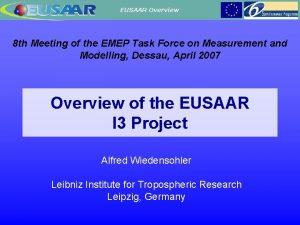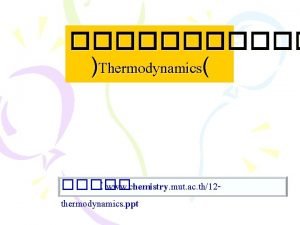EMEP TFMM 7 th MEETING HELSINKI 10 th12






























![STEP 3: Chemical composition of particles 4 main sources [sea-spray aerosol] = (Na+ + STEP 3: Chemical composition of particles 4 main sources [sea-spray aerosol] = (Na+ +](https://slidetodoc.com/presentation_image_h2/45f793d8edd24d95b2b2bceb3a732daf/image-31.jpg)





















- Slides: 52

EMEP TFMM 7 th MEETING – HELSINKI, 10 th-12 th May 2006 PM 10 and PM 2. 5 MASS CLOSURE in the LAZIO region (CENTRAL ITALY) Cinzia PERRINO C. N. R. Institute of Atmospheric Pollution Montelibretti (Rome) A study funded by the Lazio region

OUR STARTING POINT ROME – TRAFFIC STATION : 194 PM 10 EXCEEDANCES IN 2004 C. Perrino C. N. R. Istituto sull’Inquinamento Atmosferico – Montelibretti (Roma)

WHICH ARE THE DRIVING FACTORS DETERMINING THE TIME PATTERN OF ATMOSPHERIC POLLUTANTS? WHICH CONDITIONS LEAD TO EXCEEDANCES? WHICH COMPOUNDS ARE RESPONSABLE FOR THE INCREASE IN PM CONCENTRATION? WHICH SOURCES ARE RESPONSABLE FOR THE DIRECT OR INDIRECT PRODUCTION OF THESE COMPOUNDS? C. Perrino C. N. R. Istituto sull’Inquinamento Atmosferico – Montelibretti (Roma)

“Fine Dust” 2004 - 2005 A research project funded by the Lazio Region MONTELIBRETTI semi-rural station VITERBO urban station FONTECHIARI regional background station ROMA VILLA ADA urban background station ROMA MONTEZEMOLO traffic station C. Perrino LATINA urban station C. N. R. Istituto sull’Inquinamento Atmosferico – Montelibretti (Roma)

Study of the chemical composition of atmospheric particles ü apportionment of particle sources ü discrimination between natural and anthropogenic events October 2004 – July 2005 (daily sampling – analysis of the 140 most interesting days) Six stations: 1 regional background, 1 urban background, 1 peri-urban, three urban stations (Roma, Latina Viterbo) Two size fractions: PM 10, PM 2. 5 C. PERRINO - C. N. R. Institute of Atmospheric Pollution

3 -step procedure: 1. Mixing properties of the lower atmosphere Natural radioactivity monitoring 2. Size distribution of particulate matter Optical particle counter 3. Chemical composition of particles Analysis of metals, ions, carbon compounds C. N. R. Institute of Atmospheric Pollution – Rome (ITALY)

atmospheric concentration of pollutants emission mixing properties of the lower atmosphere (and physico-chemical trasnformation) Having information about the air volume available for pollution dispersion we could uncouple pollutants variations due to changes in the emission rate from those due to changes in the dilution properties of the atmosphere C. N. R. Institute of Atmospheric Pollution – Rome (ITALY)

STEP 1: Mixing properties of the lower atmosphere 222 RADON SHORT-LIVED RADON PROGENY 238 URANIUM C. N. R. Institute of Atmospheric Pollution – Rome (ITALY) DECAY CHAIN

STEP 1: Mixing properties of the lower atmosphere Convective mixing of the lower atmosphere: Radon dilutes into the whole mixing layer Weak mixing of the lower atmosphere: Radon is trapped in the lower layer and its air concentration increases

STEP 1: Mixing properties of the lower atmosphere ATMOSFERIC STABILITY MONITOR the instrument collects atmospheric particles and determines the natural radioactivity due to Radon progeny (1 -h average). good index of the dilution properties of the lower atmosphere identification of stability periods and advection periods

During warm months natural radioactivity shows a well-defined and modulated temporal pattern (all days are similar: nocturnal stability and convective mixing during the day) During cold months high-pressure periods are sporadic and advection often occurs. Diurnal mixing is weak and of limited duration. C. N. R. Institute of Atmospheric Pollution – Rome (ITALY)

NATURAL RADIOACTIVITY JUNE – JULY 2003 NATURAL RADIOACTIVITY DECEMBER 2003 C. N. R. Institute of Atmospheric Pollution – Rome (ITALY) ROME - Traffic station JUNE – JULY 2003 ROME - Traffic station DECEMBER 2003

STEP 1: Mixing properties of the lower atmosphere C. N. R. Institute of Atmospheric Pollution – Rome (ITALY)

STEP 1: Mixing properties of the lower atmosphere C. N. R. Institute of Atmospheric Pollution – Rome (ITALY)

STEP 1: Mixing properties of the lower atmosphere Starting from natural raadioactivity values we can develop Atmospheric Stability Indexes… EXPERIMENTAL FORECASTED … for each day, they give the probability, from the meteorological point of view, for the occurrence of an atmospheric pollution event C. Perrino C. N. R. Istituto sull’Inquinamento Atmosferico – Montelibretti (Roma)

The episode of December 27 th 2003 in Rome: traffic or meteorology? C. N. R. Institute of Atmospheric Pollution – Rome (ITALY)

C. N. R. Institute of Atmospheric Pollution – Rome (ITALY)

C. N. R. Institute of Atmospheric Pollution – Rome (ITALY)

FIRST REMARK The mixing properties of the lower atmosphere a key factor in determining PM concentration level and its time variations C. Perrino C. N. R. Istituto sull’Inquinamento Atmosferico – Montelibretti (Roma)

3 -step procedure: 1. Mixing properties of the lower atmosphere Natural radioactivity monitoring 2. Size distribution of particulate matter Optical particle counter 3. Chemical composition of particles Analysis of metals, ions, carbon compounds C. N. R. Institute of Atmospheric Pollution – Rome (ITALY)

STEP 2: Size distribution of particulate matter Optical particle counter in six size ranges: 0. 3 – 0. 5 m; 0, 5 – 1, 0 m; 2 – 5 m; C. N. R. Institute of Atmospheric Pollution – Rome (ITALY) 1, 0 – 1, 5 m; 5 – 10 m 1, 5 – 2, 0 m

STEP 2: Size distribution of particulate matter Evaluation of the ratio between the number of particles in the coarse ( > 1, 5 m) and the fine (0, 3 – 0, 5 m) ranges C. N. R. Institute of Atmospheric Pollution – Rome (ITALY)

STEP 2: Size distribution of particulate matter Daily average ratio between the number of particles in the coarse ( > 1, 5 m) and the fine (0, 3 – 0, 5 m) ranges IDENTIFICATION OF NATURAL EVENTS C. N. R. Institute of Atmospheric Pollution – Rome (ITALY)

FASE 2: DISTRIBUZIONE DIMENSIONALE DELLE PARTICELLE In the case of natural events (e. g. Saharan dust intrusions) the Atmospheric Stability Indexes are much lower than the real concentration of PM C. Perrino C. N. R. Istituto sull’Inquinamento Atmosferico – Montelibretti (Roma)

3 -step procedure: 1. Mixing properties of the lower atmosphere Natural radioactivity monitoring 2. Size distribution of particulate matter Optical particle counter 3. Chemical composition of particles Analysis of metals, ions, carbon compounds C. N. R. Institute of Atmospheric Pollution – Rome (ITALY)

STEP 3: Chemical composition of particles Chemical characterisation: 1. Anions and cations Ion chromatography (IC) (NO 3 -, SO 4=, Cl-, Na+, Ca++, Mg++, K+, NH 4+) 2. Elemental carbon and organic carbon compounds (EC, OC) Termo-optical analyser 3. Crustal metals (major components) (Si, Al, Fe, Ca, K) 4. Inorganic volatile components (ammnium chloride and nitrate) C. N. R. Institute of Atmospheric Pollution – Rome (ITALY) X-ray fluorescence (ED-XRF) Sampling by diffusion lines and IC analysis

STEP 3: Chemical composition of particles Crustal metals PM 10 PM 2. 5 Teflon filter Quartz filter ED-XRF Termooptical analyser Organic carbon Elemental carbon Extraction Trace metals plus DIFFUSION LINES at ML station ICP Univ. of Rome “La Sapienza” Chemistry Department Ion chromatography C. N. R. Institute of Atmospheric Pollution – Rome (ITALY) Anions and cations

MASS CONCENTRATION OF PM 10 IN MONTELIBRETTI (ROME) MEASURED BY THE DUST MONITOR (blue) AND RECONSTRUCTED BY THE CHEMICAL ANALYSES (red) C. N. R. Institute of Atmospheric Pollution – Rome (ITALY)

MASS CONCENTRATION OF PM 2. 5 IN MONTELIBRETTI (ROME) MEASURED BY THE DUST MONITOR (blue) AND RECONSTRUCTED BY THE CHEMICAL ANALYSES (red) C. N. R. Institute of Atmospheric Pollution – Rome (ITALY)

STEP 3: Chemical composition of particles 10 -15% of the ammonium nitrate is lost by the 20°C monitor and about 80% is lost by the 45°C monitor C. N. R. Institute of Atmospheric Pollution – Rome (ITALY)
![STEP 3 Chemical composition of particles 4 main sources seaspray aerosol Na STEP 3: Chemical composition of particles 4 main sources [sea-spray aerosol] = (Na+ +](https://slidetodoc.com/presentation_image_h2/45f793d8edd24d95b2b2bceb3a732daf/image-31.jpg)
STEP 3: Chemical composition of particles 4 main sources [sea-spray aerosol] = (Na+ + Cl-) * 1. 176 [SO 4= Mg Ca K] [crustal] = (1. 89 Al + 2. 14 Si + 1. 4 Ca + 1. 2 K + 1. 36 Fe) * 1. 12 [primary anthropogenic compounds] = EC * 2 [OM] [secondary compounds] = NH 4+ + SO 4= + NO 3 - + (OM – EC) OM = a OC C. N. R. Institute of Atmospheric Pollution – Rome (ITALY) a = 1. 6 ÷ 2. 1 [Mg Na Ti]

STEP 3: Chemical composition of particles C. N. R. Institute of Atmospheric Pollution – Rome (ITALY)

STEP 3: Chemical composition of particles C. N. R. Institute of Atmospheric Pollution – Rome (ITALY)

STEP 3: Chemical composition of particles Sea-spray events: • Na. Cl concentration increases from 1 -2% to 20 -40% • the coarse/fine ratio increases • they occur in advection conditions (generally clean air masses) • PM 10 concentretion is low; the increase due to sea-salt is generally < 10 ug/m 3 • generally they do no cause exceedances • they have low impact on PM 2. 5 concentration C. N. R. Institute of Atmospheric Pollution – Rome (ITALY)

STEP 3: Chemical composition of particles C. N. R. Institute of Atmospheric Pollution – Rome (ITALY)

STEP 3: Chemical composition of particles Saharan dust events: • crustal matter concentration increases from 10 -20% to over 50% • the coarse/fine ratio increases • they begin in advection conditions (but re-suspension may increase the time duration of the episode) • PM 10 concentretion can be very high (up to more than 100 ug/m 3) • they often cause exceedances • they also generally cause an increase of PM 2. 5 concentration C. N. R. Institute of Atmospheric Pollution – Rome (ITALY)

STEP 3: Chemical composition of particles 38. 0 g/m 3 IDENTIFICATION AND CHARACTERISATION OF NATURAL EVENTS: SEA-SPRAY AFRICAN DUST 146. 4 g/m 3 58. 8 g/m 3

SECOND REMARK Natural events can be identified from an increase of the coarse-to-fine ratio and are characterised by advection conditions C. Perrino C. N. R. Istituto sull’Inquinamento Atmosferico – Montelibretti (Roma)

STEP 3: Chemical composition of particles ELEMENTAL CARBON PRIMARY ANTHROPOGENIC POLLUTANTS C. Perrino C. N. R. Istituto sull’Inquinamento Atmosferico – Montelibretti (Roma)

STEP 3: Chemical composition of particles Average % composition of PM 10 in the Lazio region C. N. R. Institute of Atmospheric Pollution – Rome (ITALY)

STEP 3: Chemical composition of particles Average % composition of PM 2. 5 in the Lazio region C. N. R. Institute of Atmospheric Pollution – Rome (ITALY)

THIRD REMARK For primary anthropogenic pollutants we cannot identify “events” Their concentration depends on the proximity to the emission sources and their concentration variations mainly depend on the dispersion capacity of the lower atmosphere C. Perrino C. N. R. Istituto sull’Inquinamento Atmosferico – Montelibretti (Roma)

STEP 3: Chemical composition of particles SULPHATE SECONDARY POLLUTANTS C. Perrino C. N. R. Istituto sull’Inquinamento Atmosferico – Montelibretti (Roma)

STEP 3: Chemical composition of particles Average % composition of PM 10 in the Lazio region C. N. R. Institute of Atmospheric Pollution – Rome (ITALY)

STEP 3: Chemical composition of particles Average % composition of PM 2. 5 in the Lazio region C. N. R. Institute of Atmospheric Pollution – Rome (ITALY)

STEP 3: Chemical composition of particles PM 10 Secondary pollutants are homogeneously distributed at least on a regional scale. C. N. R. Institute of Atmospheric Pollution – Rome (ITALY)

STEP 3: Chemical composition of particles PM 10 PM 2. 5 PM 10 -2. 5 C. N. R. Institute of Atmospheric Pollution – Rome (ITALY)

FOURTH REMARK For secondary pollutants we cannot identify “events” Their concentration is homogeneous on a regional scale and their concentration variations mainly depend on the dispersion capacity of the lower atmosphere C. Perrino C. N. R. Istituto sull’Inquinamento Atmosferico – Montelibretti (Roma)

STEP 3: Chemical composition of particles PM 10 concentration higher than 65 g/m 3 PM 10 concentration lower than 35 g/m 3 PM composition during polluted days is very close to PM composition during clean days with the exception of days characterised by important natural events C. N. R. Institute of Atmospheric Pollution – Rome (ITALY)

THANK YOU FOR YOUR ATTENTION ! C. Perrino C. N. R. Istituto sull’Inquinamento Atmosferico – Montelibretti (Roma)

STEP 3: Chemical composition of particles

FASE 3: COMPOSIZIONE CHIMICA DEL MATERIALE PARTICELLARE PM 10 - 2. 5 SIA L’AEROSOL MARINO CHE LE SPECIE DI DERIVAZIONE TERRIGENA SONO UNA COMPONENTE QUANTITATIVAMENTE IMPORTANTE DELLA FRAZIONE COARSE C. Perrino C. N. R. Istituto sull’Inquinamento Atmosferico – Montelibretti (Roma)
 Chondrosis intervertebralis
Chondrosis intervertebralis Tfmm
Tfmm Tfmm
Tfmm What is meeting and types of meeting
What is meeting and types of meeting Today meeting or today's meeting
Today meeting or today's meeting Meeting objective
Meeting objective What is meeting and types of meeting
What is meeting and types of meeting Varaamo
Varaamo Timo heikkinen helsinki
Timo heikkinen helsinki Lennot helsinki silicon valley
Lennot helsinki silicon valley Wma helsinki declaration
Wma helsinki declaration Kinaporinkatu 2
Kinaporinkatu 2 Finlanda suprafata
Finlanda suprafata Fysiikan laitos helsinki
Fysiikan laitos helsinki Páneurópai folyosók
Páneurópai folyosók Työsuojelupäällikkö koulutus
Työsuojelupäällikkö koulutus Declaracion de helsinki
Declaracion de helsinki Fmi helsinki
Fmi helsinki Yksityinen vs julkinen terveydenhuolto
Yksityinen vs julkinen terveydenhuolto Lillian helsinki
Lillian helsinki Kylän kattaus ruokalista koulut
Kylän kattaus ruokalista koulut Testbed helsinki rain
Testbed helsinki rain Hero helsinki
Hero helsinki Edu hel sähköposti
Edu hel sähköposti Lennot helsinki antananarivo
Lennot helsinki antananarivo Dunkin donuts weaknesses
Dunkin donuts weaknesses Declaration of helsinki
Declaration of helsinki Opettajan pedagogiset opinnot helsinki
Opettajan pedagogiset opinnot helsinki Helsinki tapahtuma
Helsinki tapahtuma Declaração de helsinque
Declaração de helsinque Klaava helsinki
Klaava helsinki Sisu university of helsinki
Sisu university of helsinki Helsinki 1964 declaration
Helsinki 1964 declaration Aikuiskasvatustiede helsinki
Aikuiskasvatustiede helsinki Mika vornanen
Mika vornanen Interflora finland helsinki
Interflora finland helsinki Ten-t hálózat magyarországon
Ten-t hálózat magyarországon Metropolitan
Metropolitan Esperi untuva
Esperi untuva Hodan yusuf omar helsinki
Hodan yusuf omar helsinki Kieleily
Kieleily Testbed helsinki wind
Testbed helsinki wind Irish embassy helsinki
Irish embassy helsinki Teremok helsinki
Teremok helsinki Interkulttuurisuus
Interkulttuurisuus Helsinki university physics
Helsinki university physics Energiarenessanssi
Energiarenessanssi Osallistumistodistus malli
Osallistumistodistus malli Helsinki lappeenranta
Helsinki lappeenranta Helsinki business polytechnic
Helsinki business polytechnic Declaracion de helsinki
Declaracion de helsinki Testbed helsinki
Testbed helsinki Meeting point
Meeting point
